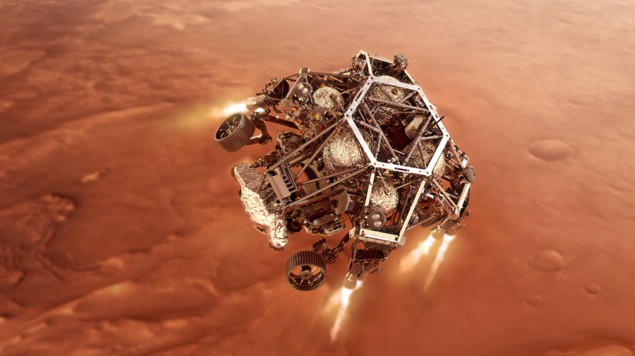
NASA’s Perseverance rover has landed on Mars, completing its seven-month journey to the red planet. The Mars 2020 mission will search for signs of ancient microbial life and collect rock samples that will be returned to Earth later in the decade. Perseverance’s arrival marks the end of a busy February for Mars exploration, with the United Arab Emirates and China successfully delivering Mars orbiters earlier this month.
At 20:55 GMT, mission control at the Jet Propulsion Laboratory in California confirmed that the car-sized rover had touched down in the Jezero Crater – a treacherous landscape pockmarked with boulders and steep cliffs. The craft was autonomously guided to the ground by the Terrain Relative Navigation system, which referenced live photos of the surface against a hazard map generated from Mars orbiters.
“What an amazing day,” says Steve Jurczyk NASA’s acting administrator. “What an amazing team, to work through all the adversity and all the challenges that go with landing a rover on Mars plus the changes of Covid.”

A Martian detective
The Jezero Crater, a 45-kilometre-wide basin, was selected because of its potential for holding signs of past life. Geologists believe that around 3.5 billion years ago a river in this region flowed into a large body of water, forming a river delta. This part of the Martian surface also shows signs of volcanic and hydrothermal activity – processes that likely played a role in how life emerged on Earth.
This watery region dried out once Mars’ geomagnetic field died away early in its history, leaving the Martian surface exposed to the solar wind. But what astronomers want to know is whether primitive organisms existed on our planetary neighbour before it turned into the harsh barren world we see today.
“We all have this curiosity about whether or not we are alone, or if there is a potential for life to have existed somewhere else. Being able to find evidence of that would be amazing,” says Kelsey Moore, a geobiologist at NASA’s Jet Propulsion Laboratory.
In an ideal world, astronomers would find an actual fossil of a bacterial cell or a microbial mat – the type of patchy green substance found covering rocks on Earth. But they are more likely to have to make do with chemical clues for life obtained by the rover’s SHERLOC instrument. Scanning the Martian surface with a laser, it will search for organic compounds and build a surface map of rock mineralogies.
The PIXL instrument, meanwhile, will map the chemical composition of rocks and sediments.

Perseverance also carries a subsurface radar system and 19 cameras. Guided by this imaging array, the rover will collect over 30 rock cores using a drill attached to a robotic arm. These samples will eventually be returned to Earth as part of the NASA/ESA Mars Sample Return campaign, which could launch as soon as 2026.
“If we see something that is really fascinating, we’ll take a pencil-like core, seal it up and place it next to the rover,” says Luther Beegle, SHERLOC’s principal investigator. “The next rover will pick it up and bring it back to Earth where we’ll be able to look for evidence of life in terrestrial laboratories.”
Paving the way for humans
The initial science mission will last one Mars year (about 687 Earth days), though Beegle hopes it can continue doing valuable science for much longer, just like the Curiosity rover which is still operational 10 years since it landed.
The Mars 2020 mission also carried the Ingenuity Mars Helicopter, a 1.8kg experimental device that might enable future Mars exploration to include an aerial dimension. Ingenuity will attempt up to five test flights within a 30-Martian-day (31-Earth-day) demonstration window.

Searching for signs of past life on Mars with NASA’s Perseverance rover
Another aspect of the mission is to pave the way for human exploration. Perseverance carries materials that could be used in spacesuits to see how they cope in the Martian climate. Its MOXIE instrument, meanwhile, will produce oxygen from Mars’ carbon dioxide atmosphere, demonstrating a way that future explorers might produce oxygen for rocket propellant as well as for breathing.
